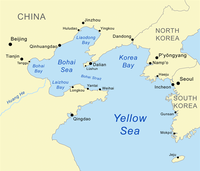
Photo from wikipedia
Perfluorooctane sulfonate (PFOS) and perfluorooctanoic acid (PFOA) are extremely persistent in the environment, and have the potential for long-range transport. The present study focused on the Daling River and its… Click to show full abstract
Perfluorooctane sulfonate (PFOS) and perfluorooctanoic acid (PFOA) are extremely persistent in the environment, and have the potential for long-range transport. The present study focused on the Daling River and its tributary, a larger river flowing into Liaodong Bay of the Bohai Sea. Recent studies have shown the elevated levels of PFOS and PFOA in the Daling River. Hence, the objective of this study was to investigate the seasonal changes, fate and transport modeling of PFOS and PFOA concentrations using one-dimensional DHI MIKE-11 river model. We designed three scenarios to assess the risk of PFOS and PFOA in surface water: the measured concentrations, constant maximum and the magnitude of a continuous constant load. The mean absolute errors divided by the mean of measured concentrations were 41-64% for PFOS and 29-36% for PFOA. The result indicated that PFOS and PFOA in the downstream of the Daling River would not reach a harmful level with the current load. The fluorochemical parks contributed an average of 44.57% of the total PFOS and 95.44% of the total PFOA flow that reached the estuary. The mass flow was observed as 1.74 kg y-1 for PFOS and 40.57 kg y-1 for PFOA to the Bohai Sea. These modeling results may be useful for monitoring the status and trends of emerging POPs and will help the determination of the risk to both humans and wildlife, in the estuarine and coastal areas of the Bohai Sea, China.
Journal Title: Chemosphere
Year Published: 2017
Link to full text (if available)
Share on Social Media: Sign Up to like & get
recommendations!